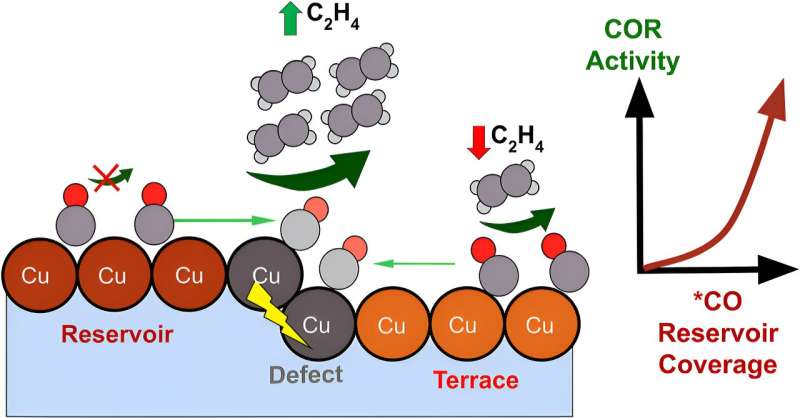This article has been reviewed according to Science X's editorial process and policies. Editors have highlighted the following attributes while ensuring the content's credibility:
fact-checked
trusted source
proofread
Looking at the importance of catalyst sites in electrochemical CO₂ conversion

Intense research efforts have been directed toward studying the electrochemical conversion of CO2, a major greenhouse gas, into platform chemicals and fuels. The success of this technology can enable the decarbonization of some of the largest CO2 emitters, including steel, cement, and chemical manufacturing industries.
Copper is unique in its ability to convert CO2 at low temperatures to a diverse range of products, such as carbon monoxide, ethylene, and ethanol at industrially viable current densities. As a result, there is widespread interest in understanding CO2 conversion on copper electrodes as efficient and stable CO2 electrolyzers.
In a recent study involving a multi-disciplinary team from Lawrence Livermore National Laboratory (LLNL), Lawrence Berkeley National Laboratory, University of California Berkeley, and the Korea Advanced Institute of Science and Technology (KAIST), researchers used chemical transient kinetics and microkinetic modeling to understand the atomistic scale workings of copper electrodes during electrochemical conversion of carbon monoxide, a key reaction intermediate in electrochemical CO2 conversion.
Their findings were published as an open-access article in the journal ACS Catalysis.
Using a simple experimental protocol involving the repeated switching of gas feed from argon to carbon monoxide, researchers find that carbon monoxide conversion to multi-carbon products can proceed at the same rate for several seconds even after the gas feed is switched from carbon monoxide to argon (referred to as the delay time). This observation motivated the team to understand the origin of the delay time and its implications for designing efficient catalysts for this important reaction.
"Our surprising finding from this work is that the effective catalytic activity of the reaction improves when there is a larger fraction of less-active sites [termed reservoir sites]. We developed a microkinetic model involving three site types to explain our findings," said LLNL researcher and co-first author Nitish Govindarajan.
"Our findings indicate that catalyst active sites cannot be analyzed in isolation from their neighbor sites. Rather, we must consider how the entire catalyst site network works cooperatively to establish a supply chain of reactants to the most active sites," said LLNL co-principal investigator Christopher Hahn.
More information: Chansol Kim et al, Importance of Site Diversity and Connectivity in Electrochemical CO Reduction on Cu, ACS Catalysis (2024). DOI: 10.1021/acscatal.3c05904
Provided by Lawrence Livermore National Laboratory





















